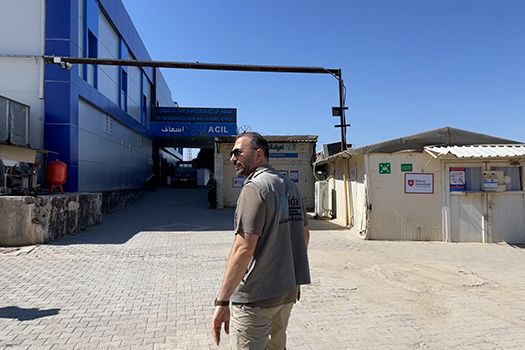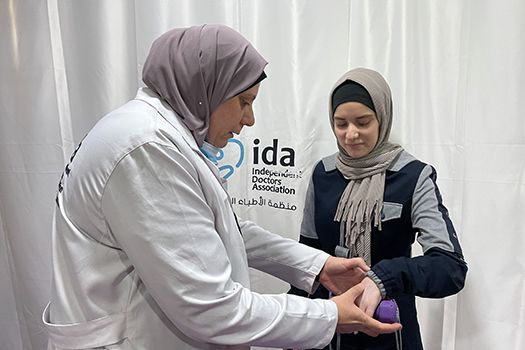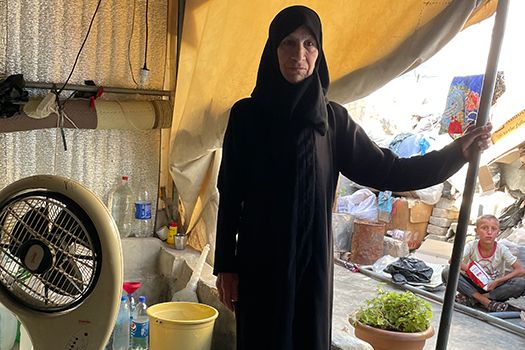
She wouldn't let go of her grandmother's hand

The name of the clinic just behind the Turkish-Syrian border crossing Bab al Salam is as special as its background: Dr. Muhammed Wasim Maaz Hospital. Dr. Maaz was a paediatrician in Aleppo that died at the age of 36 in an airstrike on a hospital on 27 April 2016. According to Physicians for Human Rights, 949 medical professionals died in Syria between the start of the war in 2011 and March 2024 and more than 90 % of them while working in a healthcare facility. However, the clinic named after Doctor Maaz, operated by the Syrian organization IDA and supported by Malteser International, is not just a memorial to a doctor murdered in the war. It is a lifeline for around 1.5 million people in the region, who receive medical care that cannot be found anywhere else within a radius of 20-30 kilometers. Around 60 % of them are refugees.
12 hours under rubble

During the war, 14-year-old Hala Kadour lost a brother. Three other siblings, her aunt and grandmother died under the rubble of the apartment when the four-story house collapsed on top of them in the 2023 earthquake. "When the earth started shaking, my father shouted for me to run out of the house, but I ran back because my little brother and my grandmother were still there. At that moment, the house collapsed." It took helpers 12 hours to rescue her from the rubble. She held on to her grandmother's hand the whole time. The left side of her body was shattered and she had numerous fractures.
When Hala Kadour was admitted to hospital after the earthquake, the doctors didn't think they would be able to save her arm. She was in intensive care for two months. Today, around a year and a half later, the 14-year-old can move her hand again and her foot has also been restored despite the numerous broken bones.
Her whole life, Hala has only known war and displacement, as the fighting began when she was just a baby, more than 13 years ago. "I was born in Idlib, in Saraqip, but when the war broke out, my family fled with me and my siblings to Jindires." That's also where she was buried during the earthquake.
"She had numerous fractures in her hand and foot, and her muscles were destroyed. She spent two months in our clinic and was initially only able to move around in a wheelchair. Now she is almost fully recovered. There are only a few neurological problems in her hand, which is why she still comes twice a week for physiotherapy," explains Dr. Abdulhannan Jouja, who treated her at the time.
The family's home in Jindires has been destroyed and Hala still has to go to the clinic regularly, so they now live in Azaz, near the hospital. Once again, Hala has to start all over again.
"My parents often tell me what it was like when there was no war in Syria, and I imagine it was wonderful. All my relatives lived nearby and they could visit each other. Now they all live scattered in many countries. Some in Libya, in Saudi Arabia, in Turkey. When we had to leave our home for the first time, we felt like refugees. But when we came to a place in Jindires where we knew other people, we started to feel at home. But when the earthquake happened, everything went back to square one. Now there are only four of us left in Azaz, we have lost everything again and the rest of our family is gone," says Hala.
Despite all her losses, Hala fought her way back to life after the earthquake. With the help of doctors and physiotherapists – and with her iron will. She says she wants to be a doctor when she grows up. Her time in hospital left its mark on the 14-year-old.
One of about seven million

62-year-old Najah Hantosh still remembers her escape well. At the time, she was 50 years old and already a widow with three children. Like more than seven million people in Syria, she now lives as a refugee in her own country. Before the war, she lived in the city of Aleppo, just like Dr. Muhammed Wasim Maaz. "My life was difficult even before the war. My husband and one of my sons died. I worked as a day laborer and did whatever work was available. I have three children, two of whom live with mental disability. But the war made our lives even more difficult. When the bombs fell and it became increasingly difficult to earn money, I decided to leave. All I could take with me was one change of clothes. When I arrived here, my children and I slept on the bare floor at first," explains Najah Hantosh. Gradually, various aid organizations gave her the bare necessities of life for herself and her children.
The clinic, which was converted from a former warehouse in 2014, has become a special place for her. Not only can she have her stomach problems treated there. but Najah can also earn some money at the hospital from time to time. On the first floor, in a small separate room, she looks after the children of the medical staff who are taken to the clinic, for example when the mothers are still breastfeeding. This helps her to make ends meet. However, she does not have to look after many children at the moment.
After more than 13 years of war, Najah Hantosh no longer hopes for peace or a return to her old home. But she has now found a new home here in the camp, right next to the Muhammes Wasim Maaz Hospital.
The illusion of safety

Deep-seated fear and trauma are recurring themes during my journey. Even when we travelled to the Idlib region two days later. This region is currently controlled by the radical Islamic organisation Hayat-Tahrir-al-Sham. For reasons of cultural sensitivity, but also for our own safety, the women in our travel group therefore wear an abaya, an ankle-length dress that is worn over their clothes. It feels unfamiliar and I'm not as flexible as I normally am.
After crossing the border, we head south to Armanaz. I have never seen so many refugee shelters in such a small space. And this despite the fact that the ground is so littered with stones that I can hardly imagine how tents or containers can even be set up here. I meet Dr Ibrahim Al-Khatib at the Armanaz Surgical Hospital run by our partner organisation HIHFAD (Hand in Hand for Aid and Development). Shortly after the earthquakes he told us how terrible the situation in the hospital was. Today I want to know what the situation is now. "Looking back, the earthquakes were the worst thing I've ever experienced," says Dr Al-Khatib. "The situation here was already bad before the earthquakes. Hundreds of thousands of people had fled to this area before the war because they thought they could live here in safety. But then the earthquakes struck and many lost their homes again, lost family members and friends. It affected me deeply and I was really emotionally worn out," says Dr Al-Khatib.
People in Syria still need our support!
There is very little reporting on the situation in Syria, as other crises have taken centre stage. But the fear of the people here is palpable. Last year's earthquake has left people feeling even more vulnerable than they already were due to the ongoing violence, as the seemingly safe regions of Idlib and Afrin have suddenly become a death trap for more than 7,000 people.
I am travelling home with mixed feelings. On the one hand, we have seen that our support is reaching people, especially in the medical sector with well-equipped clinics. But on the other hand, it was abundantly clear how great the need is, how much will be needed for a long time to come and how important it is that we do not forget the people in Syria. I definitely hold them close to my heart and am very grateful that they spoke to me so openly and shared their stories with me.
(Katharina Kiecol, January 2024)








